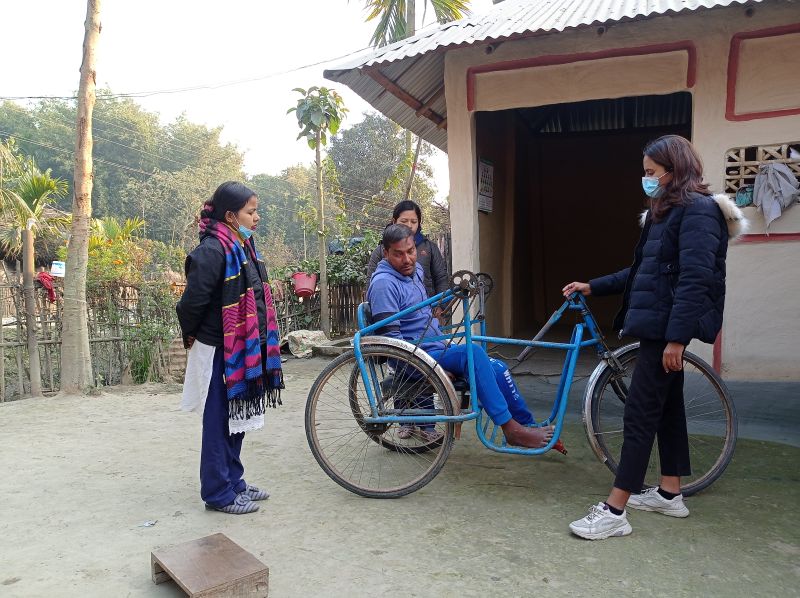Cost-effectiveness of the Disability, Prevention and Rehabilitation Program (DPRP) in Koshi province (2019-2023): summary of main findings (June 2024)
Karuna Foundation Nepal, together with Netherlands-based, independent health economist Kelsey Vaughan, assessed the cost per disability-adjusted life year (DALY) averted of the DPRP program in Koshi province through June 2023. DALYs are a measure of overall disease burden and the cost per DALY averted is the single most widely used and accepted metric for assessing cost-effectiveness of healthcare interventions in settings like Nepal. This is also a highly relevant metric for Nepal as it was used in the Nepal Health Sector Programme (NHSP) I and II[1].
Methods
The study assessed actual program expenditures during the period 2019-2023 and calculated the number of disability-adjusted life years (DALYs) averted by DPRP’s rehabilitation component, in order to estimate the cost per DALY averted. DALYs averted were estimated for a large sample of 990 PWD using information about each person’s disability type(s) and sub-type(s), which correspond to disability weights, and the improvement noted by the community-based rehabilitation facilitators (CBRFs) as a result of services received through DPRP. Improvements were translated into DALYs “gained back” or averted. Findings were then extrapolated to remaining PWD enrolled in 58 palikas as part of batches 1 and 2[2].
Main findings
- Improvements in health and quality of life: Persons with disability saw, on average, a 15% improvement in their health and quality of life (measured in DALYs) as a result of DPRP activities which helped them better manage their condition, fully or partially alleviate it or live a higher quality of life as a result of improved access to education or livelihood training.
- Low cost per DALY averted: The cost per DALY averted is estimated at NPR 35,677-50,312 (€264-373). This is only slightly higher than the average of interventions implemented under NHSP I and II (NPR 28,641-29,237 or €201-206, in 2023 prices) and therefore can be considered cost-effective in the Nepal context.
- Strong provincial and palika support: CBR expenditures were shared between Karuna Nepal (40%), Koshi province (26%), participating palikas (26%) and Karuna Netherlands (8%); palikas also contributed in-kind with staff time for meetings (estimated value: NPR 12.9 million). Compared to I2C in Ilam, DPRP increased cost sharing with the province and palikas. Financial contributions from the Ministry of Social Development (MoSD) increased as the program rolled out, despite a reduction in the overall MoSD budget. This reflects government’s strong commitment to the program.
Table 1 Provincial spending on DPRP as percentage of provincial MoSD budget (in NPR), 2076/077-2078/079 (2019-2022)
| Financial year | MoSD budget (NPR) | Total DPRP spending (NPR) | Total DPRP spending as % of provincial budget |
| 2076/077 (2019/20) | 4,166,875,000 | 7,675,551 | 0.18% |
| 2077/078 (2020/21) | 5,302,075,000 | 80,584,663 | 1.52% |
| 2078/079 (2021/22) | 4,831,839,000 | 97,895,707 | 2.03% |
Source: Own calculations, based on provincial budget data provided by Karuna Foundation Nepal and provincial DPRP spending based on expenditure records provided by Karuna Foundation Nepal.
Note: from 2079/080 (2022/23), MoSD funded DPRP’s CBR (non-prevention) activities while prevention was moved to the Ministry of Health (MoH). Total MoSD and MoH spending on DPRP declined between 2078/079 (2021/22) and 2079/080 (2022/23), both in absolute values and as a share of total budgets (from NPR 97.9 million to 72.0 million and from 2.03% to 1.35%). This may be more reflective of DPRP activities and resource needs in this year than provincial commitment to the program.
Need for continued support in Koshi province
Ongoing financial support from the province and participating palikas is needed for CBRF and District Support Facilitator (DSF) salaries, organizations of persons with disability (OPDs), program focal persons and a limited set of activities. However, exact resources needs are unknown but are likely to be less than previous years as the program enters a new phase of continuing to support existing activities and previously-identified PWDs, without new activities or further identification of PWDs.
Implications of findings for replication provinces
For replication provinces, these findings can be used as benchmarks to estimate financial resource needs. For initial program years, we suggest using NPR 19,555-27,586 per beneficiary (PWD), or NPR 4,889-6,897 (€36-51) per beneficiary per year. Per capita per year, this is NPR 60.25 (€0.45). The exact resource needs may vary in other geographies and are likely to be influenced by a number of other factors, including existing disability infrastructure, number of PWD, etc.
[1] Ministry of Health and Population Government of Nepal. (2010). NEPAL HEALTH SECTOR PROGRAMME-IMPLEMENTATION PLAN II (NHSP-IP 2).
[2] 21,578 enrolled through June 2022, 30,440 through June 2023.

